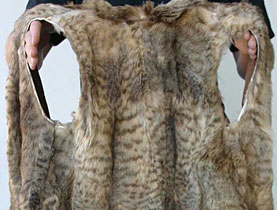
Cat furs cause furore in Switzerland

Pressure is growing in Switzerland for tighter legislation on the trade in cat fur, to bring the country into line with the European Union.
The Swiss association SOS Chats has launched a petition calling for a ban on hunting stray cats, and preparing and exporting cat skins. So far it has attracted over 50,000 signatures, including those of Brigitte Bardot, Michael Schumacher and former Miss Switzerland Lauriane Gilliéron.
The ban also has support in parliament: a member of the House of Representatives, Luc Barthassat, is to submit a motion later this year.
Switzerland has banned the import of cat fur since 2006, largely because of concern over cruel methods of slaughter in exporting countries.
But when new legislation comes into force by the end of 2008 banning the production of these furs throughout the European Union, Switzerland will be out of step with its neighbours.
“That’s why discussion has also started in Switzerland if it should be allowed to produce furs from cats and dogs,” Marcel Falk of the Swiss Federal Veterinary Office told swissinfo.
SOS Chats co-founder Tomi Tomek said her organisation had support from within the government.
“When we wrote to Mrs Calmy-Rey, the president, [Foreign Minister Micheline Calmy-Rey, Swiss president in 2007], she was very shocked… She said she wanted things to change. So we have launched a petition to help her to change it.”
The movement has support from members of parliament across party boundaries, not just Luc Barthassat’s Christian Democratic Party.
The main opposition comes from hunters and farmers. According to Tomek, tanners will pay farmers SFr15 per cat: “It’s not much, but it’s something,” she commented.
Rheumatism remedy?
The demand for cat fur – if it exists – is mainly as a remedy for rheumatism, despite the fact that specialists say its power to help is an old wives’ tale.
The Federal Veterinary Office has asked tanners about their production, and does not believe the production is very large.
“It’s not an interesting market. As far as we know, only a couple of dozen cat furs are produced [in Switzerland annually],” said Falk.
SOS Chats, on the other hand, maintains that tens of thousands of cats are killed every year for their fur.
Tomek said that when she pretended to be a customer looking to buy a cat skin, tanners were open with her about their procedures.
“In September, October, November and December the hunters and the people who work for the tanners go out and shoot all the feral cats or all cats which are 200 metres away from homes,” she said.
Tomek believes that recent publicity has made tanners less ready to advertise this particular ware. But when she posed as a customer, she found no problem in getting quotes for cat fur blankets.
“They would tell us: ‘We can make you a blanket of four or six [animals] for 360 euros’,” she said.
Cross-border traffic
It may not only be Swiss cats which are affected. There have been reports of increasing numbers of cats disappearing from areas of France close to the Swiss borders. Concern has been whipped up by a number of reports on French television channels last month.
But Swiss fur traders say it would not be economical for anyone to kill a cat and transport it so far when the returns are so low.
“We have no indication that there’s a new problem of cats disappearing,” Falk commented. “Cats are always disappearing. People are looking for their cats, and cats are also found and we cannot find the owner of the cat.”
Cat owners have a special relationship with their cats, which makes the cat-fur trade especially distressing, Tomek pointed out.
“On one side I understand that it is shocking for people who have cats that cat furs are used. From the point of animal welfare it’s more important how these cats are kept, how they are slaughtered, that it is done as carefully as possible,” said Falk.
swissinfo, Julia Slater
The Swiss Federal Veterinary Office issues permits for the import of furs and fur products to Switzerland.
All furs and pelts require a permit apart from the following: Sheep, lamb, goat, kid, calf, foal, rabbit, mink, racoon, nutria, musquash, red fox and farmed fox.
Pelts from endangered species require a special certificate, and in many cases their import is banned completely.

In compliance with the JTI standards
More: SWI swissinfo.ch certified by the Journalism Trust Initiative



























You can find an overview of ongoing debates with our journalists here . Please join us!
If you want to start a conversation about a topic raised in this article or want to report factual errors, email us at english@swissinfo.ch.